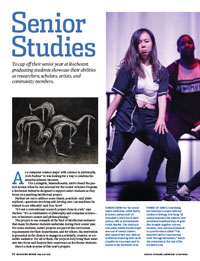Features
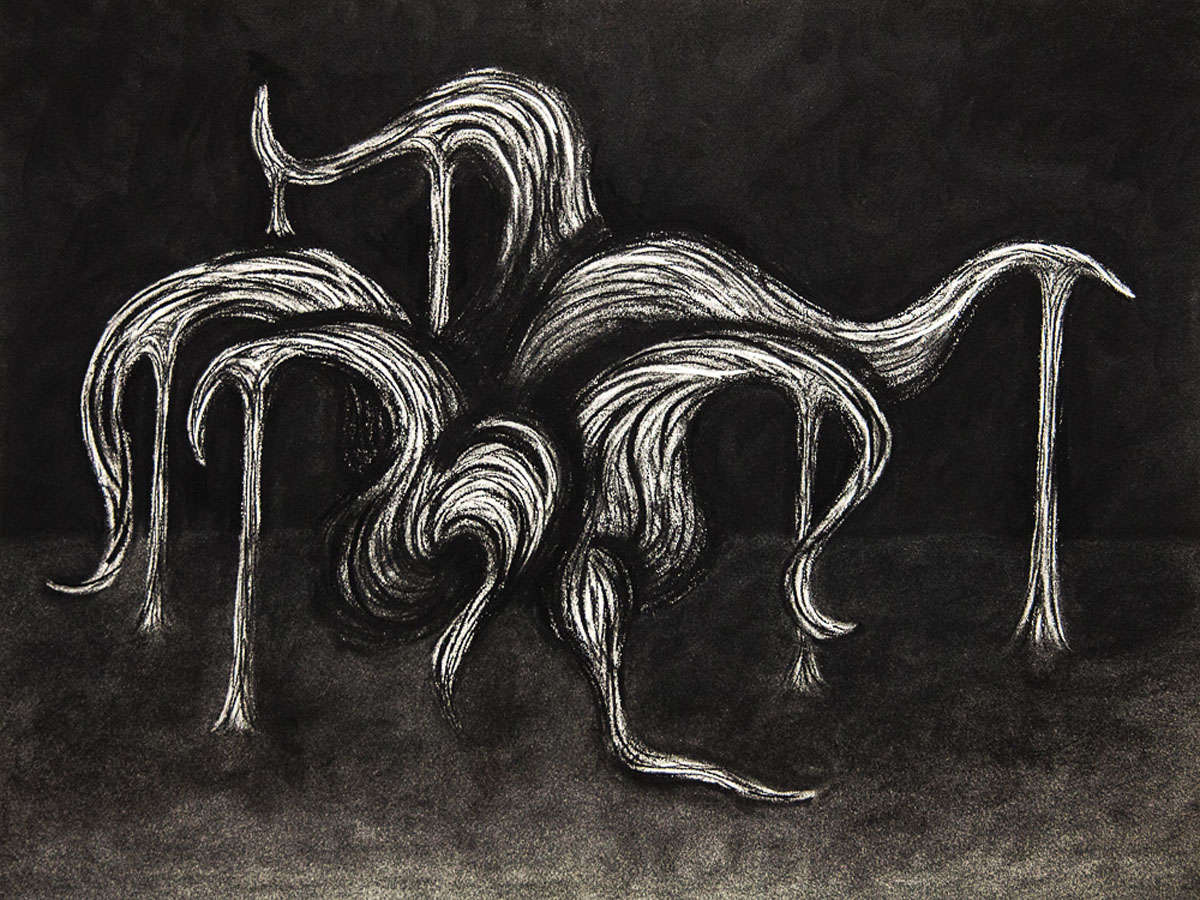 SENIOR SHOW: For her senior thesis exhibition, titled toxins, Brianne Landwersiek ’18 displayed a selection of work (above, left) at the Rochester Public Market. The studio art and public health double major was one of several seniors who capped their year with an exhibition featuring their work at galleries on campus and in spaces in the Rochester area. (Photo: Courtesy of Brianne Landwersiek ’18)
SENIOR SHOW: For her senior thesis exhibition, titled toxins, Brianne Landwersiek ’18 displayed a selection of work (above, left) at the Rochester Public Market. The studio art and public health double major was one of several seniors who capped their year with an exhibition featuring their work at galleries on campus and in spaces in the Rochester area. (Photo: Courtesy of Brianne Landwersiek ’18)As a computer science major with a minor in philosophy, Josh Pachter ’18 was looking for a way to combine his interdisciplinary interests.
The Lexington, Massachusetts, native found the perfect avenue when he was selected for the Senior Scholars Program, a Rochester initiative designed to support select students as they focus on a yearlong intellectual project.
Pachter set out to address some timely, practical—and philosophical—questions involving self-driving cars: can machines be trained to act ethically? And if so, how?
“It’s not a conventional research project done in a lab,” says Pachter. “It’s a combination of philosophy and computer science—lots of literature review and philosophizing.”
The project is one example of the kind of intellectual endeavor that many Rochester students undertake during their senior year. For some students, senior projects are part of the curriculum requirements for their departments, and for others, the motivation is grounded in the chance to engage in a scholarly, creative, or scientific endeavor. For all of them, the projects help bring their interests into focus and deepen their experience as Rochester students.
Here’s a look at some of this year’s projects.
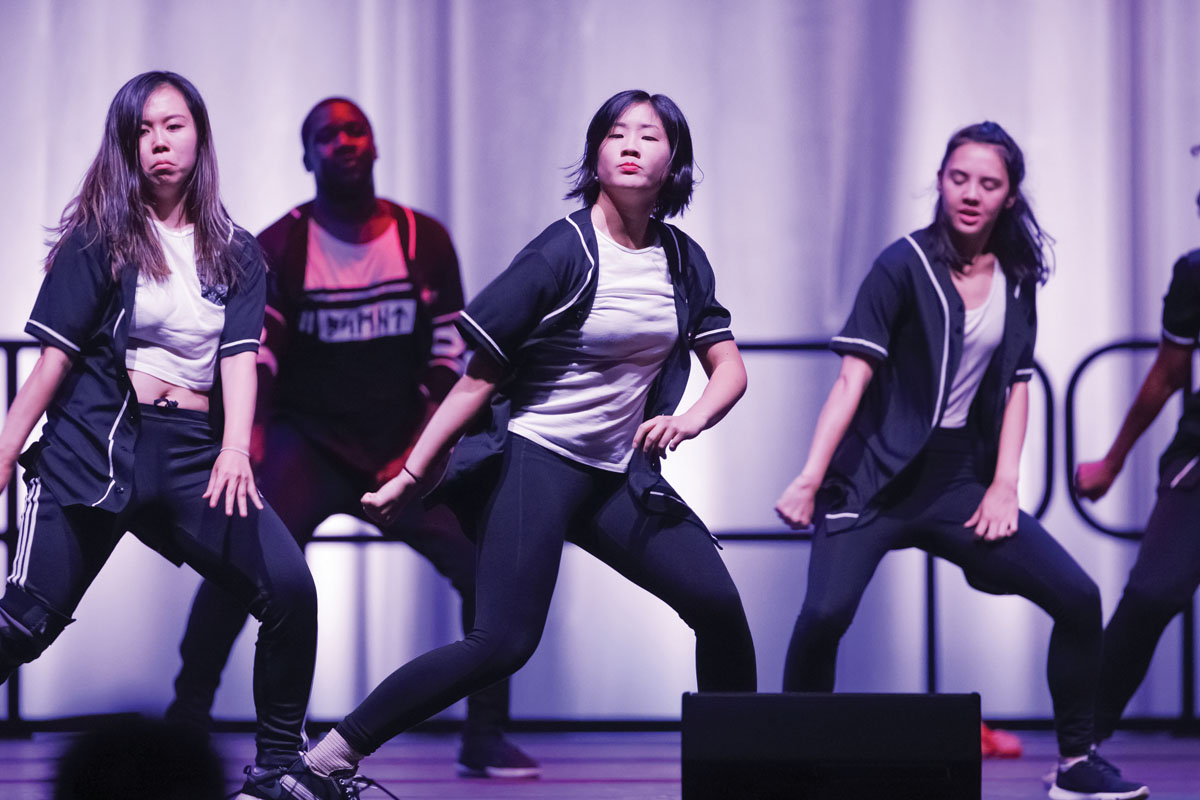 POWER OF DANCE: Combining her interests in dance with her studies in biology, Erin Dong ’18 (above) explored the physical and emotional manifestations of grief. She brought together science, emotion, and creative movement in a performance called “The Beautiful Awful: Experiencing Grief Through Movement,” which she presented at the end of the academic year. (Photo: Aaron Raymond)
POWER OF DANCE: Combining her interests in dance with her studies in biology, Erin Dong ’18 (above) explored the physical and emotional manifestations of grief. She brought together science, emotion, and creative movement in a performance called “The Beautiful Awful: Experiencing Grief Through Movement,” which she presented at the end of the academic year. (Photo: Aaron Raymond)The Biology of Grief—through Dance
Erin Dong ’18 knew from a young age that she wanted to study biology. While at Rochester, she supplemented her coursework with stints as a volunteer in rehabilitation physical therapy at the Medical Center and as a research assistant in the School of Nursing.
But what surprised her was that she also developed a love of dance, leading to a double major in both biology and dance.
For her senior project, Dong created a dance called “The Beautiful Awful: Experiencing Grief Through Movement” that combines aspects of both her majors. Along the way, she learned lessons about the creative process, taking risks, and the wisdom that can come from failure.
“I only started dancing when I came to college,” Dong says. “But I love how it’s this universal way of expression. I wanted to help people remember the loss they felt and experienced, connect to others who also shared that, and allow them to feel the emotions in their entire bodies, not just in their heads.”
Dong started her project by examining other performances, specifically work by Bill T. Jones and the dance company MBDance, which visited Rochester in January.
At about the same time, her beloved grandmother, Peggy, passed away. While at a conference in Boston, she saw a dance by students at Bates College in which choreographers had asked people how they would spend their last days on Earth. The dancers’ movements mirrored the answers, which ranged from “sitting and watching the sun rise” to “eating a gallon of ice cream with my childhood sweetheart.”
“Seeing this dance is when I finally cried about my grandmother, because I was able to connect to the joy, but also the pain and the sadness, evident onstage,” Dong says. “The piece really coaxed out my emotion and gave me a safe space to feel.”
She wanted to create a similar kind of space in her own dance, one in which people would have an outlet to grieve freely. She turned to her knowledge of anatomy and physiology to create a piece that incorporated both the emotional aspects and the physical symptoms of the grieving process.
Her faculty mentor, Anne Harris Wilcox, a senior lecturer in the Program of Dance and Movement, says building on such a broad understanding of the body’s anatomy and mechanics, and the functions involved in movement, are important in dance.
Dong’s final product was a meditation on grief that brings together science, emotion, and creative movement. But it’s the lessons she learned from the process that Dong will carry with her. This summer she starts a three-year doctoral program for physical therapy at the University of Pittsburgh.
—Lindsey Valich
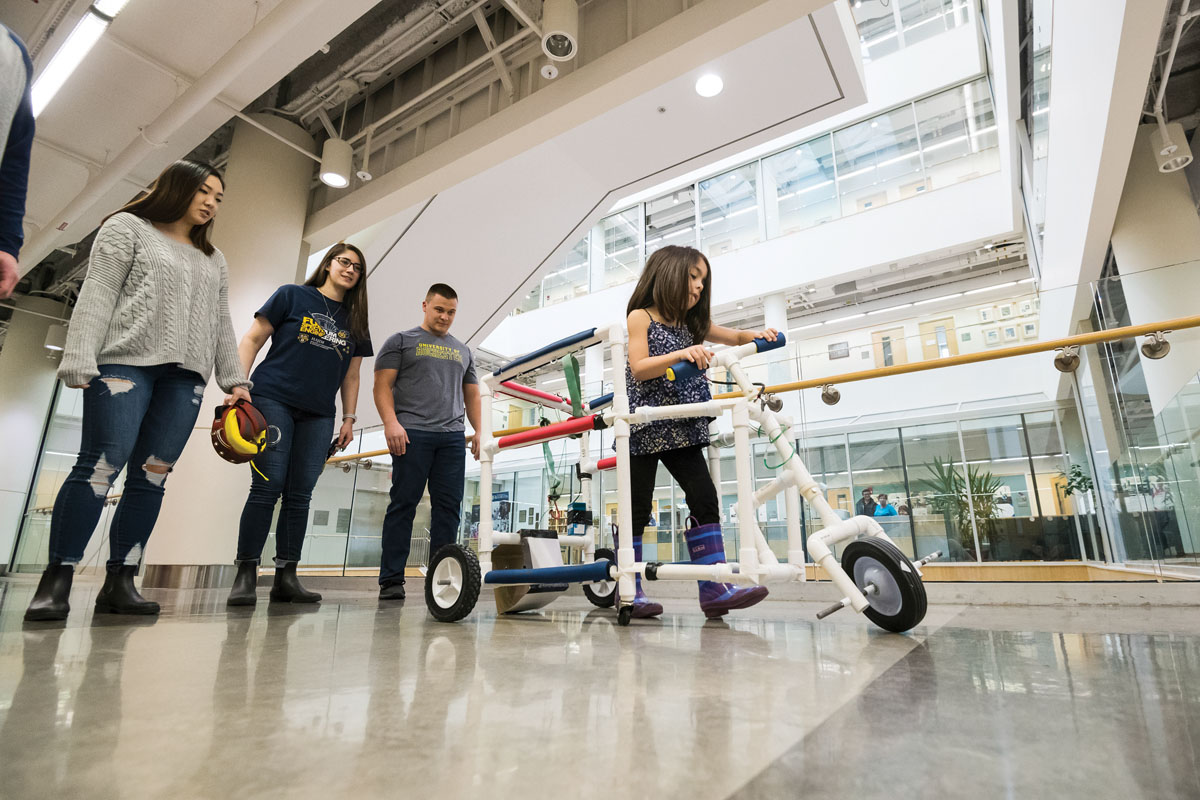 WALKING TALLER: Rosemary Buckley, the daughter of Mark Buckley, an assistant professor of biomedical engineering, tests a
walker designed by a team of senior engineering students, including Jennifer Choi, Devan Foggio, and Jo Cappotelli. (Team
member Daniel Myers is not pictured.) (Photo: J. Adam Fenster)
WALKING TALLER: Rosemary Buckley, the daughter of Mark Buckley, an assistant professor of biomedical engineering, tests a
walker designed by a team of senior engineering students, including Jennifer Choi, Devan Foggio, and Jo Cappotelli. (Team
member Daniel Myers is not pictured.) (Photo: J. Adam Fenster)Building a Better Walker
For young children with Down syndrome, cerebral palsy, and other developmental disabilities, learning to walk can be a long-term process. In the meantime, the children find it hard to keep up with their peers, which can increase their social isolation.
A team of biomedical engineering majors, working with Leah Talbot, a Rochester-area physical therapist, hopes to address both issues with an inexpensive, “hybrid” walker that will be portable enough to accompany the children wherever they go.
“This is right up our alley,” says Joe Cappotelli ’18, whose senior design project teammates Hyun Jennifer Choi ’18, Devon Foggio ’18, and Daniel Myers ’18 developed a prototype for a less expensive, more therapeutically sound walker. The design consists of a frame of relatively light-weight plastic tubing, an adjustable harness to support a child, a steering column, and an axle assembly to propel everything.
As the students surveyed commercially available walkers, they found two main options. One kind enabled 3- to 5-year-olds to keep up with their peers, but weren’t very helpful from a therapeutic standpoint because they didn’t require children to propel themselves. Walkers used in clinical settings, on the other hand, were often bulky and expensive—great for therapy, but not for keeping up with more mobile playmates, or for taking home.
The team “has definitely come up with a very unique idea to help children with motor delays learn to walk in a fun and active way,” Talbot says. “Ideally this motorized walker will allow these children to access their environment to play with their peers while improving their cognitive, motor, and social skills.”
—Bob Marcotte
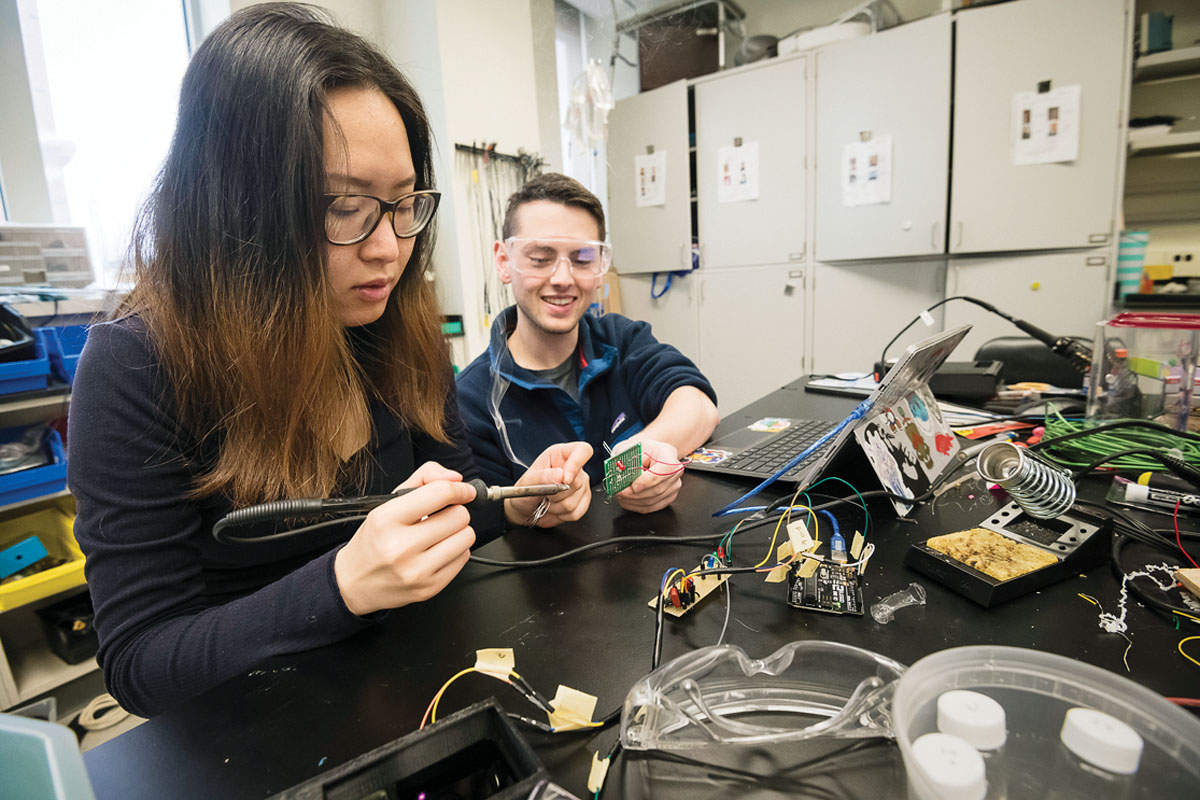 TEST TAKERS: Seniors Sue Zhang and Matt Boulanger (top) work on a device that uses ultraviolet light (above) to help identify
biomarkers for diabetes. The team developed the portable screening device for use in testing people living in remote areas
of Micronesia. (Photo: J. Adam Fenster)
TEST TAKERS: Seniors Sue Zhang and Matt Boulanger (top) work on a device that uses ultraviolet light (above) to help identify
biomarkers for diabetes. The team developed the portable screening device for use in testing people living in remote areas
of Micronesia. (Photo: J. Adam Fenster)Making Diabetes Screening Portable
The diabetes that’s endemic in Micronesia is a legacy of modern store-bought foods and a less strenuous lifestyle than South Pacific islanders enjoyed before the encroachment of Western culture.
But detecting and treating the disease in Micronesia is complicated by the fact that electrical power and cell phone coverage is erratic or nonexistent in many of the remote villages and outer islands. Moreover, many of the inhabitants are distrustful of Western medicine, and reluctant to travel to clinics or hospitals for help.
To address such challenges, four biomedical engineering students worked with Timothy Dye, a professor of obstetrics and gynecology at the Medical Center, on a portable diabetes screening device that could be carried by health workers into remote areas. The device could make it easier to identify people at high risk of the disease. Dye’s research team is eager to test such a device on Pohnpei Island.
“This would help start the educational process with people who are kind of scared of Western medicine and who think hospitals are where you go to die,” says Matt Boulanger ’18, who was part of a senior design team that also included Jack Hayden ’18, Fredella Lee ’18, and Sue Zhang ’18.
The students took their cue from a Dutch technology that uses skin tissue as a biomarker of diabetes and other age-related disorders. The team came up with a device that looks like a small black box with an opening where a patient’s arm is placed for screening. A form of ultraviolet light bounces off the skin to detect biomarkers for diabetes. While there’s more research and testing to do, faculty members in biomedical engineering and optics were impressed.
“This is exactly what we want—something that’s portable, easy to use, and can help us provide some actual clinical information in the field and is not just estimating risk based on weight and symptoms,” says Dye.
—Bob Marcotte
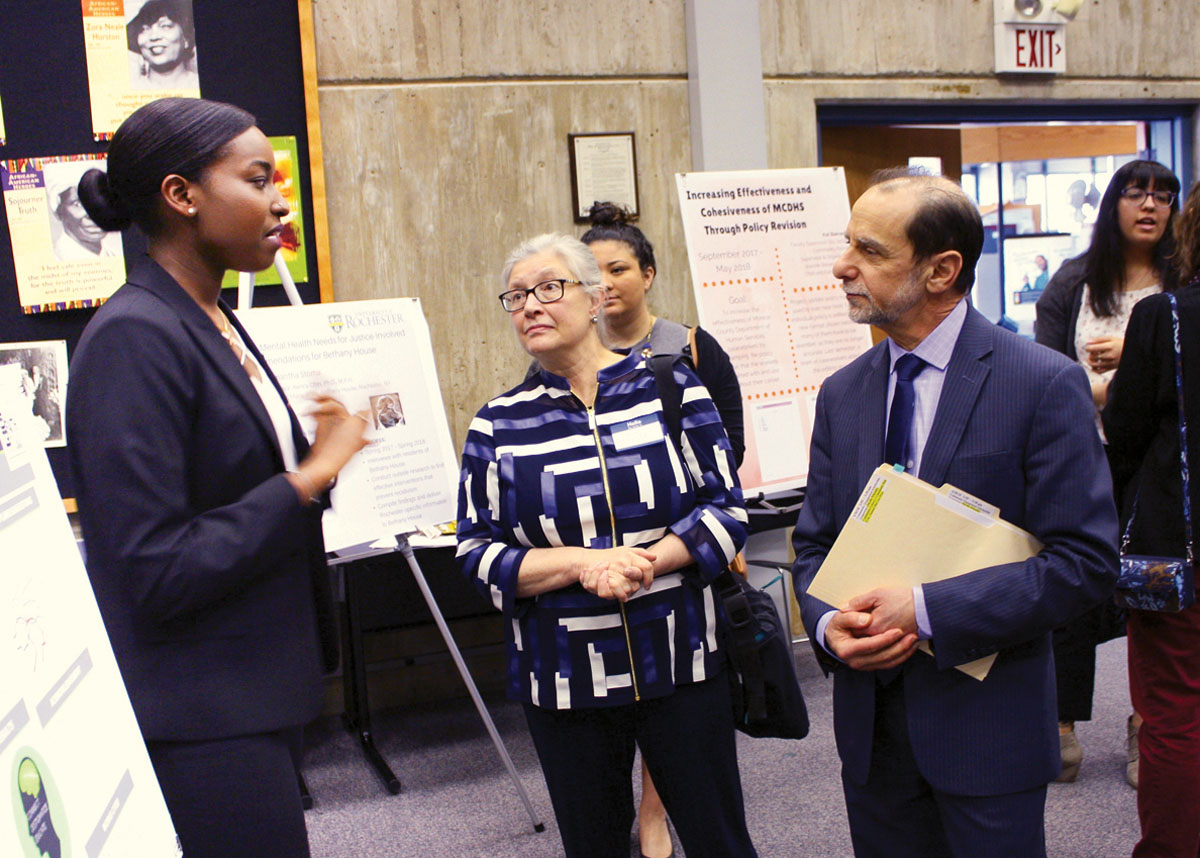 COMMUNITY NEWS: During a poster session this spring, Leslie Kaze ’18 (left) shares her project in community-engaged scholarship with associate professor Nancy Chin (center) and President Richard Feldman (right). (Photo: Jim Ver Steeg)
COMMUNITY NEWS: During a poster session this spring, Leslie Kaze ’18 (left) shares her project in community-engaged scholarship with associate professor Nancy Chin (center) and President Richard Feldman (right). (Photo: Jim Ver Steeg)Engaging the Community
As a senior selected for a new initiative, Leslie Kaze ’18 set out to share her academic interests as a public policy major with the Office of Mental Health Promotion in Rochester.
Among the first students at Rochester to receive a citation in community-engaged scholarship, Kaze and a handful of other seniors completed capstone projects in which they worked with nonprofits and other organizations as a way to help address local, national, and global challenges while weaving their connections to the community into the curriculum.
Administered by the Rochester Center for Community Leadership, the program pairs students with a faculty mentor to work with a community organization. For her project, Kaze worked with Anne Marie White, director of the Office of Mental Health Promotion, to explore how social stigma might keep church-going African-American millennials from using mental health care services. Others in the first group were Emma Baker ’18, a studio art major who worked with Taproot Collective in Rochester with Heather Layton, a senior lecturer in the Department of Art and Art History; Katherine Bakrania ’18, a political science major who worked with the Monroe County Division of Child and Family Services in Rochester with Stu Jordan, an associate professor of political science; Katheryn Lapusnak ’18, a political science major who worked with LifeMoves in Menlo Park, California, also with Jordan; Shoshana Preuss ’18, a health, behavior, and society major who worked with Common Ground Health in Rochester with Ted Brown, the Charles E. and Dale L. Phelps Professor of Public Health and Policy; and Samantha Stoma ’18, a health, behavior, and society major who worked with Bethany House in Rochester with Nancy Chin, an associate professor at the Center for Community Health and Prevention.
—Jim Ver Steeg
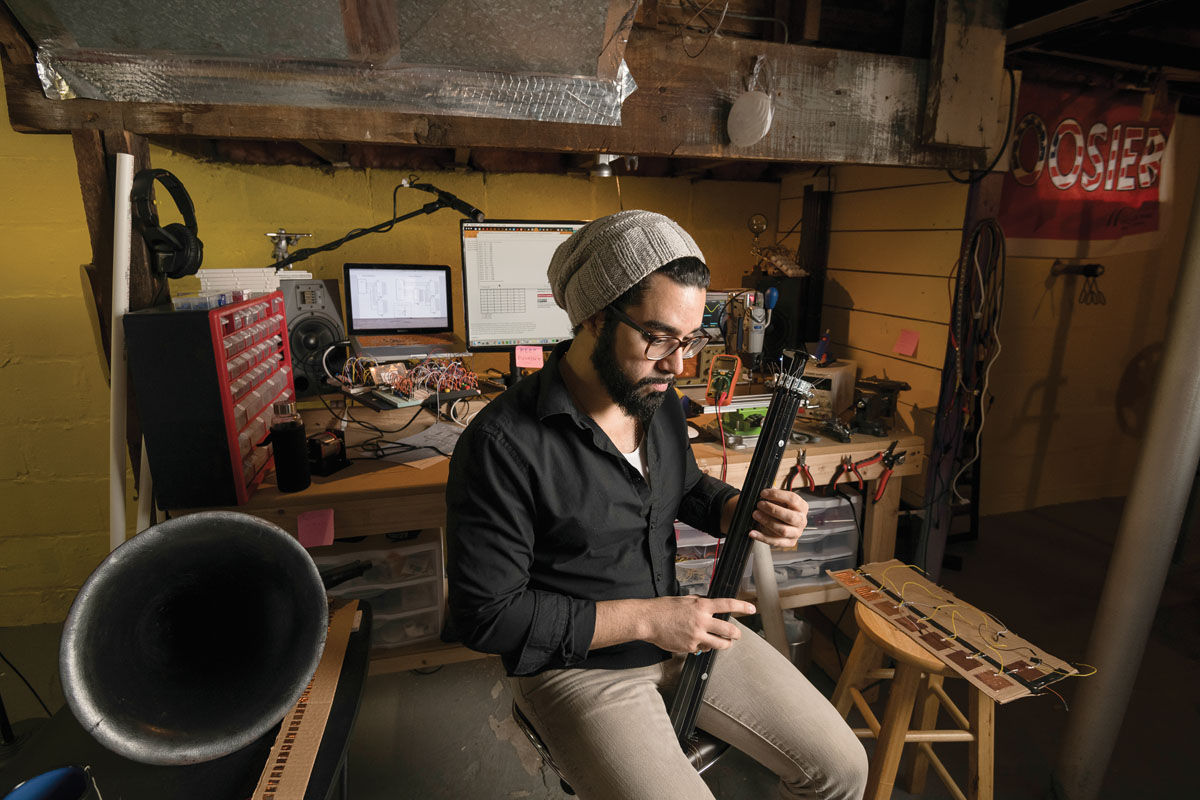 SOUNDER SYSTEM: Juan Estrella works on an electronic musical interface that he hopes will give musicians a much greater range
of possibilities for making music than that offered by traditional instruments. (Photo: J. Adam Fenster)
SOUNDER SYSTEM: Juan Estrella works on an electronic musical interface that he hopes will give musicians a much greater range
of possibilities for making music than that offered by traditional instruments. (Photo: J. Adam Fenster)Engineering a Better Guitar
Juan Estrella ’18 is a classical guitarist who chafes at the constraints traditional instruments place on artistic expression.
“We can still create great art, but not as great as it would be with better tools,” he says.
Estrella, who was in the audio and music engineering program, is attempting to create a “new electronic musical interface” that would free musicians from those constraints—and set a new standard for instrument design.
This is not just a senior design project, Estrella says. “I regard it as my life’s work.”
A traditional six-string guitar has a range of only three octaves. Two hands are required to produce a single note: One to fret, the other to pluck. “That’s really inefficient,” Estrella says.
What does he have in mind?
“Basically, think of an elliptical guitar neck, two feet long, with 48 frets and 14 strings that go all the way around,” Estrella says. “Retractable legs on both ends lift it off the table.”
The instrument will produce tones over 12 octaves—using just the three strings on top of the neck. Tones are generated by simply pressing the strings against a touch screen wrapped around the underlying surface.
In other words, no more plucking. Both hands are free to fret chords and scales, while simultaneously adjusting pitch, volume, vibrato, speed, loop, distortion, or any other user defined effect, thus making guitar foot pedals obsolete as well.
The idea is to create tones that merge together in a continuous sequence, like a singer’s voice—not in discrete notes, or “chunks,” which is still the case even with many of the new musical interfaces on the market, Estrella says.
Estrella has completed the neck and the stands and has attached the strings. The next challenge is creating a touch screen and coming up with the electronics needed to process as many as 672 inputs.
“That’s a tough engineering problem,” says David Anderson, an assistant professor of electrical and computer engineering, who supervises the audio and music engineering senior design projects.
“But it’s a neat path that Juan’s going down.”
In September, Estrella will enter the University’s technical entrepreneurship and management (TEAM) master’s program—the next step on his path to eventually starting his own company.
“I’ve never felt any ambiguity about my purpose in life, or what I’m supposed to be doing,” Estrella says. “There is nowhere else I’d rather be.”
—Bob Marcotte
The Ethics of Autonomous Vehicles
When it comes to self-driving automobiles, Josh Pachter ’18 hopes to create ethical machines through a process similar to how humans raise children. A computer science major with a philosophy minor, Pachter spent the year studying whether autonomous vehicles could learn to be more ethical.
He found that machine learning is plagued by forms of bias when programmed by humans, who bring their own moral frameworks to their work. Examples of bias include hugging the side of the road too closely or choosing to run over one group of humans rather than another based on arbitrary factors.
“If we expect autonomous cars to drive better and safer than we do, we should provide the groundwork,” he says. “We can provide some fundamental moral truths, and through a training process, the machine will ultimately learn to make good higher-level decisions without the need for bad input from its parents—humans—who are actually bad drivers.”
Pachter’s advisor, Hayley Clatterbuck, an assistant professor of philosophy, says Pachter’s synthesis of complex theories in both fields generated “fascinating” results.
“His project truly embodied the promise and necessity of interdisciplinary work. If we use machine learning to train autonomous vehicles, which machine-learning approaches should we use and on which data should we train them? Josh examined various cutting-edge machine-learning processes to determine which problems they are most apt to solve. Then, he considered what kind of problem morality is, a surprisingly complicated topic that raises many important questions.”
Last summer, Pachter landed an internship at Amazon’s Seattle headquarters. He was hired before returning to school and will begin work this September as a software development engineer.
—Jim Mandelaro
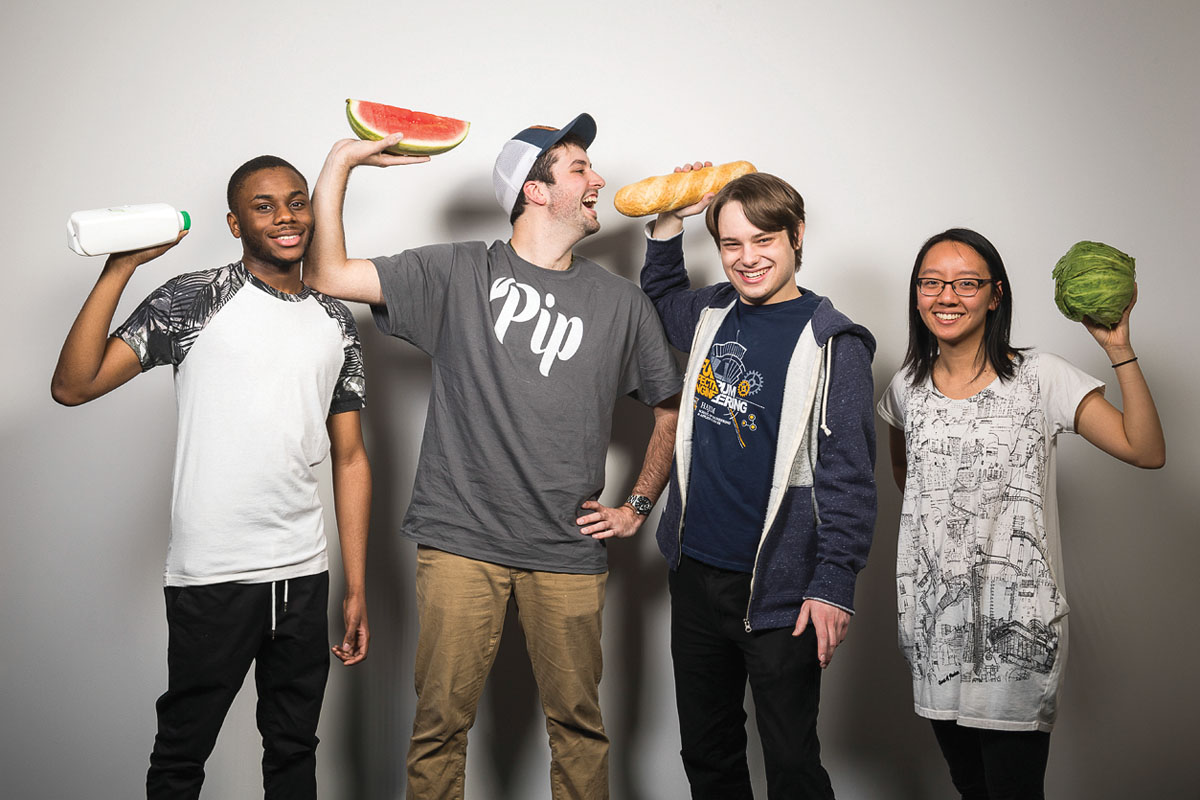 FOOD FOLLOWERS: Seniors Teron Russell, Chris Smith, Stephen Cohen, and Vivian Li developed an app to manage and inventory
items in a fridge, freezer, or pantry. (Photo: J. Adam Fenster)
FOOD FOLLOWERS: Seniors Teron Russell, Chris Smith, Stephen Cohen, and Vivian Li developed an app to manage and inventory
items in a fridge, freezer, or pantry. (Photo: J. Adam Fenster)Using an App to Reduce Waste
Vivian Li ’18 lives off campus and cooks all of her own food in order to save money. There’s one drawback. “I sometimes leave food in the fridge, and oh, two weeks later, it’s fuzzy,” she says.
She may soon have an app for that. One she helped create.
Li was the project lead on a student team that worked to design Pip, a voice-enabled mobile application for smart home assistants like Google Home and Amazon’s Alexa to help users manage their food inventory and balance their grocery budget. The project was a senior capstone for the Digital Media Studies Program, where eight senior projects emerged from a seminar course taught by Michael Jarvis, an associate professor of history and the director of Digital Media Studies, and Stephanie Ashenfelder, the program manager for studio art in the Department of Art and Art History.
Rounding out the team were Teron Russell ’18, Christopher Smith ’18, Matthew Burg ’18, and Stephen Cohen ’18.
Jarvis says that while students use their experience in the class to find success in many ways. “We have about a 95 percent job or career placement rate right now,” he says. “They either wind up working for the IBMs, Googles, and Spotifys out there or marketing firms.”
—Jeanette Colby
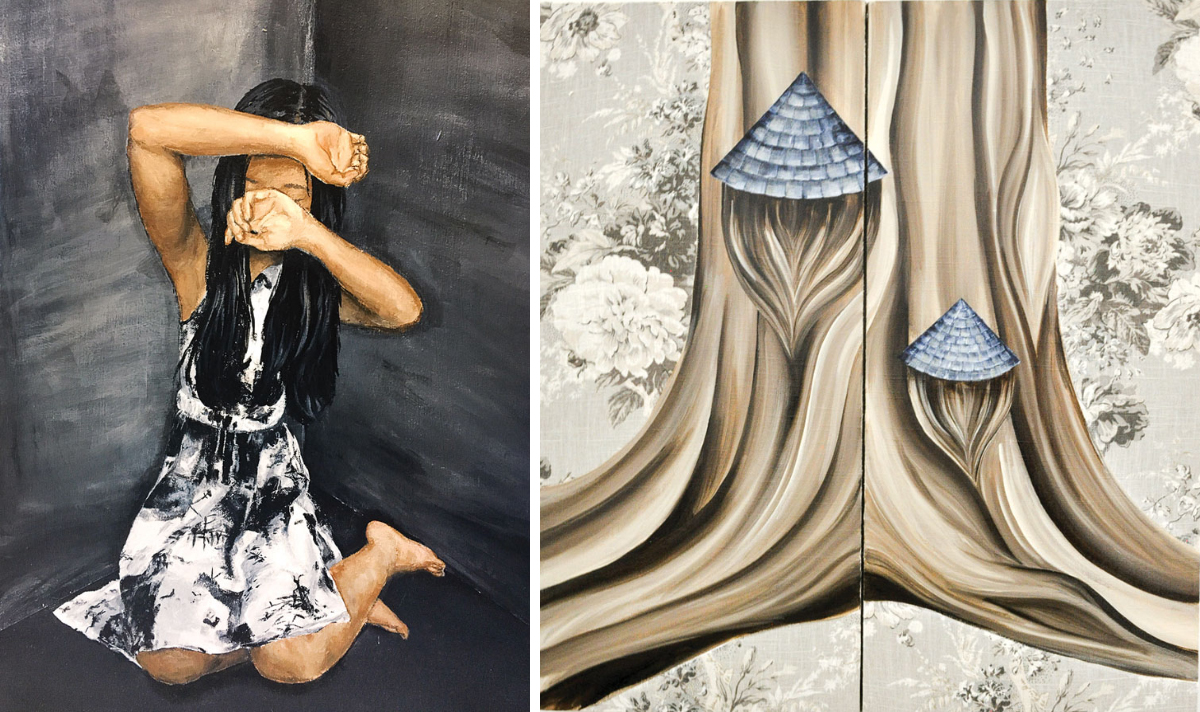 SHOWCASES: Senior art shows included work by Ruoxue (Astra) Chang ’18 (left) and Alexandra Cunningham ’18. (Photo: Courtesy of Ruoxue (Astra) Chang ’18 and Alexandra Cunningham ’18)
SHOWCASES: Senior art shows included work by Ruoxue (Astra) Chang ’18 (left) and Alexandra Cunningham ’18. (Photo: Courtesy of Ruoxue (Astra) Chang ’18 and Alexandra Cunningham ’18)An Art Exhibition of Their Own
Studio arts majors in the Department of Art and Art History capped off their senior year with an art thesis exhibition. During the spring, their work was on view in galleries on the River Campus and in the Rochester area. The 10 students graduating this year explored several themes in their shows, including the intersection of the food and pharmaceutical industries, social interaction and anxiety, and the role of the professional artist in society. The installations featured a variety of media, including acrylic on canvas, video, and audio materials.
—Jeanette Colby

